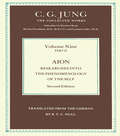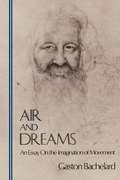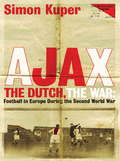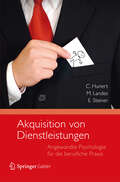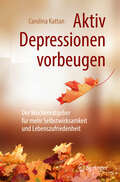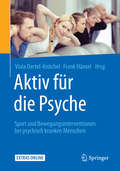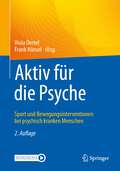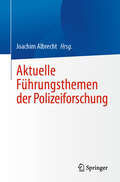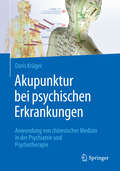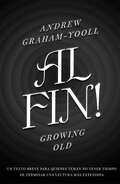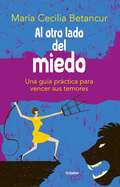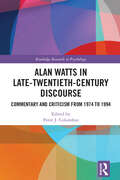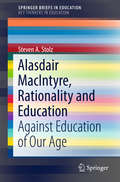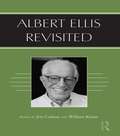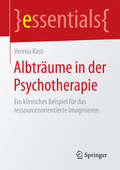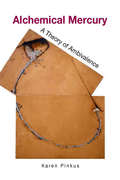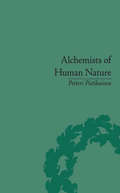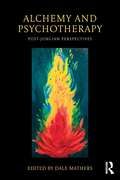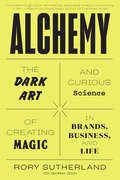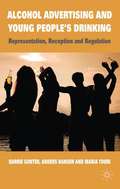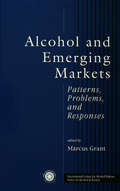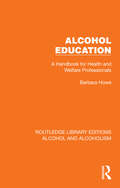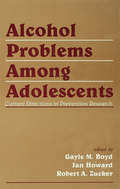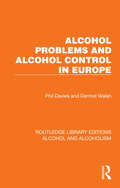- Table View
- List View
Aion: Researches Into the Phenomenology of the Self (Collected Works of C.G. Jung #56)
by C.G. JungAion is one of a number of major works that Jung wrote during his seventies that were concerned with the relations between psychology, alchemy and religion. He is particularly concerned in this volume with the rise of Christianity and with the figure of Christ. He explores how Christianity came about when it did, the importance of the figure of Christ and the identification of the figure of Christ with the archetype of the Self. A matter of special importance to Jung in his seventies - the problem of opposites, particularly good and evil - is further discussed and the importance of the symbolism of the fish, which recurs as a symbol of both Christ and the devil, is examined. As a study of the archetype of the self, Aion complements The Archetypes and the Collective Unconscious, which is also published in paperback.
Air and Dreams: An Essay on the Imagination of Movement
by Gaston BachelardEssay from one of the most significant modern thinkers in France.
Ajax, The Dutch, The War: Football in Europe During the Second World War
by Simon Kuper'Football history at its best' SCOTLAND ON SUNDAY'Hugely moving... a very good book indeed' FOUR FOUR TWO'Kuper is an original, sophisticated and adventurous writer. The story he has to tell... is fascinating and pressing' SUNDAY TIMESIn FOOTBALL AGAINST THE ENEMY Simon Kuper crossed the globe in search of the links between football, politics and culture. In AJAX, THE DUTCH, THE WAR he skilfully pieces together an alternative account of World War II. He looks at the lives of the footballers who played for the Dutch club, the officials and the ordinary fans during this tumultuous period and challenges the accepted notion of the War in occupied Europe. With almost 80 per cent of Amsterdam's Jewish Corner wiped out during the war, the long-held belief that, by and large, half the Dutch population had some kind of link to the Resistance has, of late, come into question. Kuper explores this issue and looks deeper into the role of football across Europe in the years both preceding and following the War. The result is a compelling and controversial account of the War, seen through the lens of football.
Akquisition von Dienstleistungen: Angewandte Psychologie für die berufliche Praxis
by Miriam Landes Eberhard Steiner Claus HunertErfolgreiche Verkäufer fühlen sich meist als "die Könige" des Unternehmens und dies meist mit gutem Recht, denn sie sind es, die an vorderster Front für den Erfolg des Unternehmens sorgen. Schwierig genug ist diese Aufgabe schon, wenn man ein konkretes Produkt verkaufen soll, aber das bietet wenigstens den Vorteil, dass es der Kunde im wahrsten Sinne des Wortes begreifen, es testen und auf seine Erwartungen hin überprüfen kann, bevor er seine Kaufentscheidung trifft. Die besondere Herausforderung im Verkauf von Dienstleistungen liegt darin, dass man auf der "Klaviatur" der verschiedenen psychologischen Befindlichkeiten, Erwartungen, aber auch Ängste und situativer Besonderheiten auf Seiten seines Kunden zu spielen vermag. Aufgrund angewandter psychologischen Erkenntnisse bietet dieses Werk die nötigen Einblicke für die Praxis. Auch stellt es diese Klaviatur erstmals in umfassender Weise vor und bietet darüber hinaus konkrete Handlungsempfehlungen für unterschiedliche Verkaufssituationen. Somit ist es wertvolle und zugleich ansprechend interessante Lektüre für alle, die aus beruflichen oder privaten Gründen mehr über die psychologischen Hintergründe von Akquise, Verkauf und Kaufentscheidungen erfahren möchten.
Aktiv Depressionen vorbeugen: Der Wochenratgeber für mehr Selbstwirksamkeit und Lebenszufriedenheit
by Carolina KattanManchmal drückt einfach der Schuh, aber wir wissen noch nicht genau, was wir dagegen unternehmen können. Meist schleichend kann sich aus gedrückter Stimmung und negativen Gedanken im Laufe der Zeit eine depressive Erkrankung entwickeln.Dieser Ratgeber unterstützt Sie darin, unbeschwert und zufrieden durch das Leben zu gehen: Mittels Achtsamkeit und Selbstreflexion lernen Sie Woche für Woche in zahlreichen alltagsrelevanten Übungen, Ihre Selbstwirksamkeit zu stärken, mehr Lebenszufriedenheit zu empfinden und der Entstehung von Depressionen vorzubeugen. Die 40 Übungen zu verschiedenen Lebensthemen bieten Ihnen die Möglichkeit, sich selbst besser zu verstehen, mögliche Mangelzustände zu erkennen, unter strukturierter Anleitung ungünstige Gedanken zu verändern und stärkende Ressourcen aufzubauen.Das wochenweise Vorgehen eignet sich für Menschen aller Altersklassen, die ohne große theoretische Einleitungen direkt loslegen möchten, und besonders für Menschen, die die Wartezeit auf einen Therapieplatz strukturiert und selbst aktiv gestalten wollen.
Aktiv für die Psyche: Sport und Bewegungsinterventionen bei psychisch kranken Menschen
by Viola Oertel-Knöchel Frank HänselÜberwinden Sie die Motivationsbarrieren Ihrer Patienten! Dieses multidisziplinäre Praxisbuch bietet Physiotherapeuten und anderen Bewegungsfachkräften einen praxisorientierten Handlungsleitfaden für die Durchführung von sportlichen Interventionen bei psychisch kranken Menschen. Bewegungsfachkräfte wissen zwar welche Sport- und Bewegungsinterventionen sie bei psychisch kranken Menschen anwenden können - oft aber nicht, wie sie krankheitsbedingte Motivationsbarrieren überwinden können. Dieses in der Praxis bewährte Trainingsmanual erleichtert die Vorbereitung und Durchführung von sportlichen Interventionen in der Sozialpsychiatrie und Psychosomatik und verbessert die Resultate und die Qualität der therapeutischen Arbeit.
Aktiv für die Psyche: Sport und Bewegungsinterventionen bei psychisch kranken Menschen
by Frank Hänsel Viola OertelÜberwinden Sie die Motivationsbarrieren Ihrer Patienten!In diesem Praxisbuch erfahren Sie, wie gezielte Bewegungseinheiten in der Physiotherapie dazu beitragen können, Menschen mit psychischen Erkrankungen positiv zu beeinflussen. Welche Sport- und Bewegungsinterventionen sind bei psychisch kranken Menschen sinnvoll? Wie können krankheitsbedingte Motivationsbarrieren überwunden werden? Welche Effekte hat sportliches Training auf verschiedene psychiatrische Krankheitsbilder, wie z.B. Schizophrenie, Angst- oder Essstörungen? Das Herausgeberteam liefert Ihnen die Antworten zu allen Aspekten des Trainings. Aus dem Inhalt: Medizinisches Basiswissen zum besseren Verständnis psychisch kranker Menschen, praktische Empfehlungen für Übungsleiter*innen wie Ernährungshinweise und Kontraindikationen, Werkzeugkasten mit Fotosequenzen, Trainingszielen und Anwendungsvarianten. Neu in der 2. Auflage: komplett überarbeitet, mit neuen Diagnoseschlüsseln und auf dem aktuellen Forschungsstand.
Aktuelle Führungsthemen der Polizeiforschung
by Joachim AlbrechtDieser Sammelband präsentiert herausragende Abschlussarbeiten der Hochschule für Polizei in Baden-Württemberg zu Führungsthemen im Polizeikontext und gibt damit einen Überblick über neue, anwendungsnahe Forschung auf diesem Gebiet. Das Werk richtet sich zum einen an WissenschaftlerInnen, die sich über aktuelle und relevante Themen der Polizeiarbeit und -forschung informieren möchten. Zum Zweiten sollen die hier veröffentlichten Erkenntnisse aber auch interessierten PraktikerInnen, die täglich Führungsarbeit bei der Polizei leisten, dienen. Und nicht zuletzt unterstützt dieser Band Bachelor- oder Masterstudierende, die frisch das Studium aufgenommen haben, bei der Suche nach interessanten Fragestellungen für die eigene Abschlussarbeit.
Akupunktur bei psychischen Erkrankungen: Anwendung von chinesischer Medizin in der Psychiatrie und Psychotherapie
by Doris KrügerDas Buch beschäftigt sich erstmalig mit den Möglichkeiten der Anwendung der Akupunktur in der Psychiatrie und Psychotherapie. Im allgemeinen Teil werden die Grundlagen aus der chinesischen Medizin die Nadeltechniken, die Diagnostik und das Behandlungskonzept vorgestellt. Der spezielle Teil widmet sich einer Auswahl von psychischer Erkrankungen und stellt systematische das Krankheitsbild aus Sicht der TCM, die Möglichkeiten der Akupunkturpunkte, Erfolge, Grenzen und Kontraindikation sowie Fallbeispiele mit Diagnose, Verlauf und Beispielpunktkombination vor. Die Akupunktur bietet eine nebenwirkungsarme und kostengünstige Alternative zu Psychopharmaka an und kann bei einigen Patienten schnell zu deutlich sichtbaren Linderung führen sowie Krankheitsverläufe günstig beeinflussen.
Al fin!: Growing old
by Andrew Graham YoollCompletado poco antes de su partida, este libro póstumo de uno de los periodistas más respetados y queridos propone una mirada reflexiva y humorística sobre el difícil arte de envejecer, los achaques físicos y emocionales y la cercanía del final. Envejecer implica prepararse para morir y este libro es un ejercicio en eso, en preguntarse en cómo son las cosas cuando uno no está. ¿Cómo se van a acordar del golpe de 1976 cuando ya no estemos los que lo vivimos? ¿Cómo no nos acordamos del pogrom de 1919 o las ejecuciones de Mitre? ¿Y qué se hace con las toses, el paso lento, los médicos permanentes? ¿Qué va a ser de las caras que todavía recordamos de tantos años atrás, desaparecen con nosotros? ¿Tienen razón los mexicanos? Como este es un libro de Graham-Yooll hay un par de valentías, que tienen que ver con el sexo. "La jubilación del pene" es una lección de sexualidad para la tercera edad en un bar rotoso de Barracas, seguida de un poema de Yeats sobre una amante envejecida y otro de Baudelaire. Pero también y sobre todo está una de esas cosas que salían de los cuadernos de Andrew, uno de esos espejos durísimos. Es el diálogo con su ex mujer de tantos años en una visita a la vivienda asistida donde ella penaba, un diálogo que ella lleva al sexo, a los mejores recuerdos, al ¿te acordás? más gráfico que hay. A cuando eran jóvenes y no podían esperar. Ese era Andrew Graham-Yooll, uno que se retorcía de incomodidad durante un diálogo así pero después lo anotaba fielmente para publicarlo. Era valiente, nomás, y este es un libro valiente.Del prólogo de Sergio Kiernan
Al otro lado del miedo
by María Cecilia BetancurDescubre, enfrenta y vence los temores que te impiden llevar una vida estable, tranquila y feliz. <P><P>¿De dónde provienen nuestros miedos? Saberlo puede cambiarnos la vida. Y es que los temores no tienen límites y pueden originarse por las alturas, los animales, la soledad o el rechazo. ¿Cómo debemos reaccionar frente al temor? ¿Cuál es el tratamiento adecuado? ¿Qué tipo de miedos sienten los niños? <P><P> La reconocida psicóloga María Cecilia Betancur presenta una guía que se convertirá en la herramienta indispensable para todas las personas que quieran enfrentar y vencer sus mayores temores.
Alan Watts in Late-Twentieth-Century Discourse: Commentary and Criticism from 1974-1994 (Routledge Research in Psychology)
by Peter J. ColumbusThis book is an anthology of commentary and criticism written within the transitional period between Alan Watts’ 1973 death and the twenty-first century intellectual horizon. Comprised of 16 chapters written and published between 1974 and 1994, with up-to-date introductions from the essayists and other contemporary thinkers, this volume opens a window onto unexplored grounds of Alan Watts’ impact within late-twentieth-century discourse – an intermediate space where scholars reoriented their bearings through changing times and emerging academic trends. Offering varied explanations and assessments of Alan Watts, including his influence on the Beat and Hippie generations, and his popularization of Zen Buddhism in America, it tackles unaddressed questions within the milieu of late-twentieth-century America from the Reagan Revolution and religious conservatism, to paradigm shifts in Buddhist studies and the rise of post-colonial theory. Contributors’ post-mortem analyses and critiques of Watts allow for a thematic rendering of their consonance or dissonance with noted Beat, Hippie, and Zen Buddhism themes of his lifetime. This volume will appeal to scholars and students of humanistic psychology, transpersonal psychology, the psychology of religion, comparative religion, and American studies.
Alasdair MacIntyre, Rationality and Education: Against Education of Our Age (SpringerBriefs in Education)
by Steven A. StolzDespite Alasdair MacIntyre being known as an academic who has made many notable contributions to a range of areas in philosophy, his thinking on education is not as well-known and/or properly understood by most audiences and readerships that predominantly reside in educational contexts. With this in mind, this book aims to provide a critique of MacIntyre’s thinking about education, and hence commences with a central theme found in MacIntyre’s extensive corpus concerning the fragmentation and disunification of ideas found in our culture and society that stems both from the rejection of metaphysics and what it means to be a human being living within the context of history. According to MacIntyre, part of the problem why this has occurred is due to educational institutions, particularly universities failing to resist the pressure exerted from industry and the state to conform. Unfortunately, this has resulted in a type of intellectual dissensus where the shared conceptions of rational enquiry and the role of reason have been replaced by pluralistic notions of private and personal choices concerning the good, and a disillusionment with reason that is ultimately exhibited as apathy and conformism. In order to overcome this apathy and conformism found in our culture and society, MacIntyre’s educational project is concerned with the cultivation of rationality; however, this is not an easy undertaking because it involves students being confronted with alternative – sometimes rather hostile – rival traditions so they both come to see rival points of view and understand that each tradition, including their own, does not come from a neutral or value-neutral standpoint. To MacIntyre, dialectical encounters between traditions is a crucial starting point of a good education, but for intellectual and academic progress to be made, rational enquiry needs to be grounded in a shared understanding of first principles that aims at truth and rational vindication. It is this shift in thinking that is of interest in the latter part of this book, particularly MacIntyre’s views around tradition-orientated communities of practice. Here, MacIntyre is concerned with the praxis of his educational project and the crucial role tradition-orientated communities play in the cultivation of independent reasoners who are capable of seeing the interconnectedness between different forms of knowledge that can lead us to an informed discovery of both the truth, and of the good, but most importantly exhibit virtuous dispositions which are vital to good practical reasoning.
Albert Ellis Revisited
by Jon Carlson William KnausAlbert Ellis was one of the most influential psychotherapists of all time, revolutionizing the field through his writings, teachings, research, and supervision for more than half a century. He was a pioneer whose ideas, known as Rational Emotive Behavior Therapy (REBT), formed the basis of what has now become known as Cognitive Behavior Therapy (CBT), the most widely accepted psychotherapeutic approach in the world. This book contains some of Ellis’ most influential writings on a variety of subjects, including human sexuality, personality disorders, and religion, with introductions by some of today’s contemporary experts in the psychotherapy field. The 20 articles included capture Ellis’ wit, humor, and breadth of knowledge and will be a valuable resource for any mental health professional for understanding the key ingredients needed to help others solve problems and live life fully.
Albträume in der Psychotherapie: Ein klinisches Beispiel für das ressourcenorientierte Imaginieren (essentials)
by Verena KastVerena Kast schildert, wie im Rahmen der Psychotherapie Imagination im Zusammenhang mit Albträumen als Emotionsregulierung wirken und kreative Fantasien wecken kann. Das Arbeiten mit der Imagination ist hierbei durchsetzt von therapeutischen Interventionen, mit dem Blick darauf, Imaginationen der Angst in Imaginationen überzuführen, die Zukunft ermöglichen, kreativ und oft mit Ansätzen von Freude verbunden sind. Ein klinisches Beispiel zeigt, wie eine Analytikerin mit den Albträumen der Analysandin auch die kreativen Aspekte der Imagination bearbeitet und so einen Zugang zu ihrer Ressource herstellt.
Alchemical Active Imagination: Revised Edition
by Marie-Louise von FranzAlthough alchemy is popularly regarded as the science that sought to transmute base physical matter, many of the medieval alchemists were more interested in developing a discipline that would lead to the psychological and spiritual transformation of the individual. C. G. Jung discovered in his study of alchemical texts a symbolic and imaginal language that expressed many of his own insights into psychological processes. In this book, Marie-Louise von Franz examines a text by the sixteenth-century alchemist and physician Gerhard Dorn in order to show the relationship of alchemy to the concepts and techniques of analytical psychology. In particular, she shows that the alchemists practiced a kind of meditation similar to Jung's technique of active imagination, which enables one to dialogue with the unconscious archetypal elements in the psyche. Originally delivered as a series of lectures at the C. G. Jung Institute in Zurich, the book opens therapeutic insights into the relations among spirit, soul, and body in the practice of active imagination.
Alchemical Mercury: A Theory of Ambivalence
by Karen PinkusPinkus (Italian, French and comparative literature, University of Southern California) takes the reader on a somewhat quixotic journey through the many visions of alchemy from antiquity to the present. She points out that the derivation of the word is uncertain. But this is appropriate since the definition of alchemy is also murky. Is it science or magic? Is it something as crass as turning lead into gold, or as rarified as a spiritual rebirth? While alchemies have existed for centuries, Pinkus spends the most time on the alchemical centuries, roughly (for nothing is definite) 1500-1800. She finds alchemical thoughts in Goethe, Lavoisier, the Rosicrucians and Marx among many others. Her own philosophy, as expressed through the nebulous, contradictory attitudes of thinkers toward the concept of alchemy is given with intelligence and humor. Alchemy is a metaphor but its shifting meaning is the root of this exploration into ambivalence. Annotation ©2010 Book News, Inc. , Portland, OR (booknews. com)
Alchemists of Human Nature: Psychological Utopianism in Gross, Jung, Reich and Fromm
by Petteri PietikainenA study of Modernist utopias of the mind. This book examines the psychodynamic writings of Otto Gross, C G Jung, Wilhelm Reich and Erich Fromm. It argues, utopianism became increasingly important to the fundamental ambitions of all four thinkers, and places the 'utopian impulse' with the historical context of the early twentieth century.
Alchemy and Psychotherapy: Post-Jungian Perspectives
by Dale MathersAlchemical symbols are part of popular culture, most recently popularised in the Harry Potter books. Alchemy intrigued Carl Jung, the founder of analytical psychology. It inspired him as he wrote ‘the Red Book’ - the journal of his voyage of internal discovery. He devoted much of his life to it, using alchemical symbols as metaphors for unconscious processes. Alchemy and Psychotherapy explores the issue of alchemy in the consulting room and its application to social and political issues. This book argues against the dominant discourse in contemporary psychotherapy - scientific materialism - and for the discovery of spiritual meaning. Alchemy and Psychotherapy has four main sections: ‘Alchemy and meaning’ - looks at the history of alchemy, particularly the symbol of the coniunctio - sacred marriage - a metaphor for the therapeutic relationship. 'The symbolic attitude’ - explores working with dreams, fairytales, astrology and the body: each of which is a symbolic language. ‘The spirit and the natural world’ - discusses the concept of 'burn out' - of therapists, our ecological resources, the mystical aspects of quantum physics and the philosophical underpinning of symbol formation. ‘Clinical Applications’ - shows alchemy’s use with victims of abuse, those struggling to secure gender identity, in anorexia and in ‘social healing’ - atonement and restorative justice - which apply the idea of the coniunctio. Alchemy and Psychotherapy is illustrated throughout with clinical examples, alchemical pictures and poetry which emphasise that alchemy is both a creative art and a science. Bringing together contributors from a wide range of disciplines, Dale Mathers and contributors show that therapy is both art and science, that the consulting room is the alchemical laboratory, and that their research is their creative engagement. Alchemy and Psychotherapy will be a valuable resource for practitioners, students at all levels of psychotherapy, analytical psychology, psychoanalysis and creative, art-based therapies and for creative practitioners (in film, literature and performing arts) who draw on Jung’s ideas.
Alchemy: The Dark Art and Curious Science of Creating Magic in Brands, Business, and Life
by Rory SutherlandHOW DOES MAGIC HAPPEN? The Ogilvy advertising legend—“one of the leading minds in the world of branding” (NPR)—explores the art and science of conjuring irresistible products and ideas."A breakthrough book. Wonderfully applicable to about everything in life." —Nassim Nicholas Taleb, author of The Black Swan“Veins of wisdom emerge regularly and brilliantly from these pages. Don't miss this book.” —Robert B. Cialdini, author of InfluenceWhy is Red Bull so popular, though everyone—everyone!—hates the taste? Humans are, in a word, irrational, basing decisions as much on subtle external signals (that little blue can) as on objective qualities (flavor, price, quality). The surrounding world, meanwhile, is irreducibly complex and random. This means future success can’t be projected on any accounting spreadsheet. To strike gold, you must master the dark art and curious science of conjuring irresistible ideas: alchemy.Based on thirty years of field work inside the largest experiment in human behavior ever conceived—the forever-unfolding pageant of consumer capitalism—Alchemy, the revolutionary book by Ogilvy advertising legend Rory Sutherland, whose TED talks have been viewed nearly seven million times, decodes human behavior, blending leading-edge scientific research, absurdly entertaining storytelling, deep psychological insight, and practical case studies from his storied career working on campaigns for AmEx, Microsoft, and others.Heralded as “one of the leading minds in the world of branding” by NPR, Sutherland is a unique thought leader, as comfortable exchanging ideas with Nobel Prize winners Daniel Kahneman and Richard Thaler (both interviewed in these pages) as he is crafting the next product launch. His unconventional and relentlessly curious approach has led him to discover that the most compelling secrets to human decision-making can be found in surprising places:What can honey bees teach us about creating a sustainable business?How could budget airlines show us how to market a healthcare system?Why is it better to be vaguely right than precisely wrong?What might soccer penalty kicks teach us about the dangers of risk-aversion?Better “branding,” Sutherland reveals, can also be employed not just to sell products, but to promote a variety of social aims, like getting people to pay taxes, improving public health outcomes, or encouraging more women to pursue careers in tech. Equally startling and profound, Sutherland’s journey through the strange world of decision making is filled with astonishing lessons for all aspects of life and business.
Alcohol Advertising and Young People’s Drinking
by Barrie Gunter Anders Hansen Maria TouriThere is widespread and growing concern about the use of alcohol in society, especially by young people. Although overall volumes of alcohol consumption may be levelling off, the occurrences of excessive or 'binge' drinking, especially among teenagers and young adults, are increasingly commonplace. Tackling irresponsible drinking, which is linked to other antisocial behaviour and health problems, has focused attention on the promotion of alcohol by its producers as an important causal factor. This has led to calls for tougher regulation of alcohol marketing, including restrictions on where it can occur and the form it is allowed to take. Empirical research evidence, often emanating from government funded enquiries and endorsed by health lobbies, has been cited in support of an allegedly primary role played by advertising in triggering interest in and the onset of alcohol consumption among young people and in encouraging regular and heavy drinking. Close examination of this evidence, however, reveals that the research is not always as cut and dried as it may first appear. Methodological weaknesses abound in studies of the purported effects of alcohol advertising and other forms of marketing and the significance specifically of advertising as an agent that shapes young people's alcohol consumption could be weaker than often thought. This book sets out a review and critique of the evidence on alcohol advertising and marketing effects on young people and considers this evidence in relation to codes of advertising and marketing practice.
Alcohol And Emerging Markets: Patterns, Problems, And Responses (ICAP Series on Alcohol in Society)
by Marcus GrantDivided into two parts, Alcohol and Emerging Markets begins with a series of case studies that assess alcohol issues in four regions - Asia, Central and Eastern Europe, Latin America, and Sub-Saharan Africa - and four countries - China, India, Mexico, and Russia. Issues such as past and current public policy developments, prevention programs, and treatment of alcohol related disorders are addressed as well as the health consequences of alcohol use and abuse. In the second part, the contributors consider the issues relevant to the entire geographical region covered by the book. The book also includes a chapter that examines the role of the industry in emerging markets and suggests a set of guidelines that address alcohol misuse issues.
Alcohol Education: A Handbook for Health and Welfare Professionals (Routledge Library Editions: Alcohol and Alcoholism)
by Barbara HoweAlcohol education in the 1980s was receiving greater emphasis in the training and practice of a wide range of health and welfare professionals. As we became more aware of the risks associated with excessive drinking, this practical, straightforward guide, originally published in 1989, would have been essential reading for health and welfare workers who were keen to develop the alcohol education aspect of their work and enable their clients and patients to use alcohol in a harm-free way. Barbara Howe looks at alcohol education in context, clarifying its role and place in the day-to-day work of health and welfare professionals at the time. She also discusses common myths and misunderstandings about alcohol among professionals and their clients. She describes various approaches to alcohol education and includes a series of practical exercises for use with individuals and families, aimed at increasing professionals’ confidence and competence in broaching the subject of alcohol. Although working practices may have changed since first publication, much of this title will still be useful today.
Alcohol Problems Among Adolescents: Current Directions in Prevention Research
by Gayle M. Boyd Jan Howard Robert A. ZuckerAlcohol misuse presents a major risk for health and well-being throughout the life-span, but youth have a special vulnerability. Alcohol is the most widely used drug by adolescents. For some, this may be one or two isolated occasions of youthful experimentation; for others, the use becomes excessive, placing them in danger of immediate adverse consequences such as accidental injury and alcohol poisoning, or encouraging other high-risk behavior patterns including unprotected sex. Moreover, a pattern of heavy drinking established in adolescence and young adulthood may continue into an adult pattern of alcohol abuse. Concerned communities and institutions across the nation are tackling the problem of alcohol use and abuse by young people. Research-based knowledge is urgently needed to inform these efforts and to ensure that limited prevention resources are used as effectively as possible. The origins of youthful alcohol use and abuse are found within the complex interplay of individual characteristics, family and peer influences, the larger societal context for alcohol use, environmental conditions, and maturational processes that accompany adolescence. This volume, which began as a special issue of the Journal of Research on Adolescence, contains all of the material from the journal issue plus additional chapters. It helps researchers to meet the tremendous challenge of disentangling the key determinants of risk, and developing effective interventions. Primary sources of influence on youthful alcohol use are described, ranging from individual expectancies about alcohol effects and cognitive decision processes to parenting practices, peer influences, social environments, and economic factors; and a corresponding range of prevention interventions is discussed. This book will serve as a primer to those with an interest in developing and improving effective programs and activities to reduce alcohol-related problems among young people. For those engaged in prevention research, the text will provide useful reviews and current findings that should aid in directing future research activities.
Alcohol Problems and Alcohol Control in Europe (Routledge Library Editions: Alcohol and Alcoholism)
by Dermot Walsh Phil DaviesThe nature of alcohol problems is very diverse and the strategies adopted for minimising these vary even more. Thinking in the study of alcohol problems in the 1970s and early 1980s had focused on the public health perspective, seeking not only to lessen alcohol problems by controlling the availability of alcohol, but also to promote moderate drinking practices and to preserve the positive advantages of alcohol use. Originally published in 1983, a detailed review of public health issues in this field at the time opens the book. This is followed by an examination of alcohol-related problems and policies for their control in sixteen different European countries. The chapters on individual countries provide a source of information and data on alcohol policies, consumption and problems with which it is possible to examine from a cross-cultural and comparative basis the claims of a public health perspective. The final chapter draws together the cross-national data and discusses their implications for a public health response to alcohol problems. This book should now be a historical reference source for all interested in health policy in general and alcohol problems in particular.
